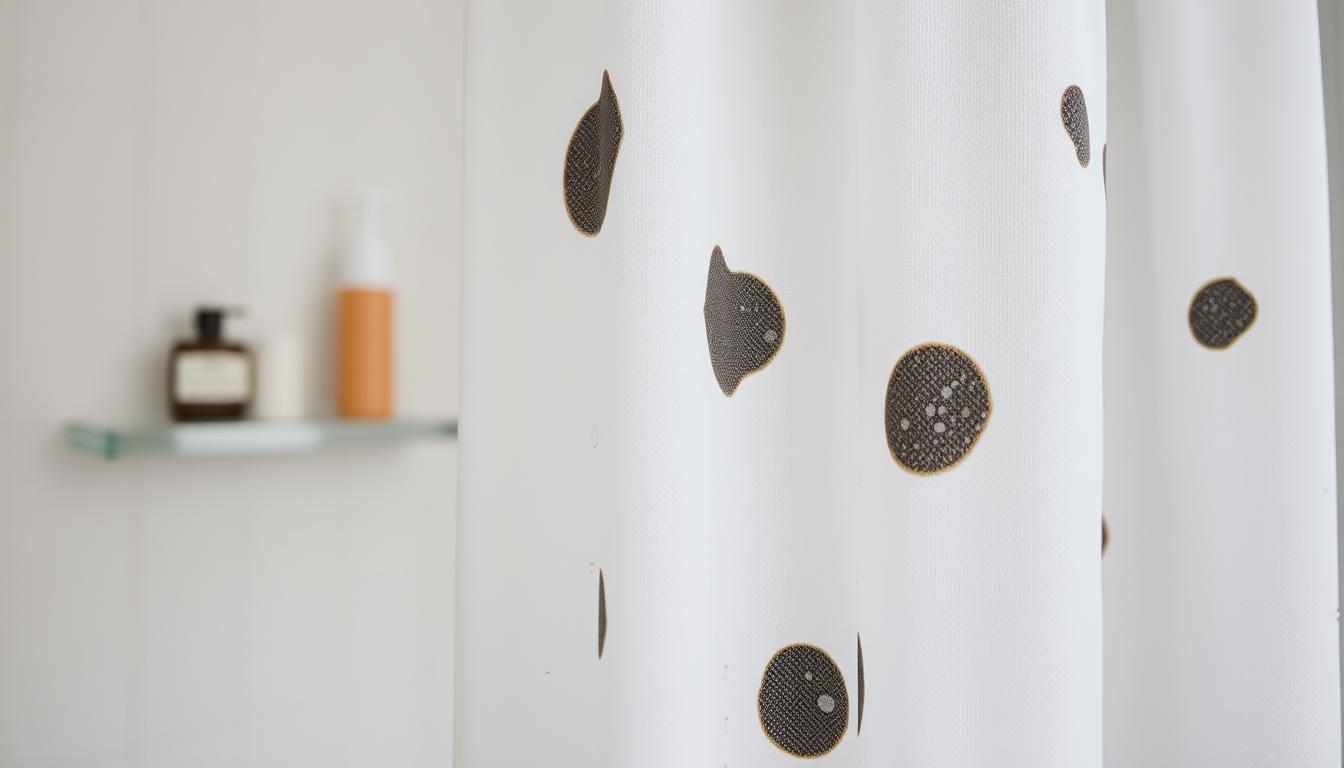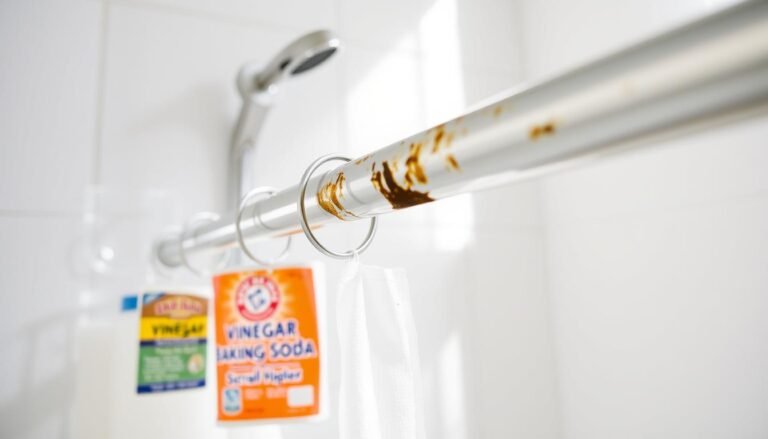Why Shower Curtain Turning Black: Causes & Solutions
Seeing black spots on your shower curtain usually means mold and mildew are present. These grow well in wet, dark places like bathrooms. It’s important to know why this happens and how to stop it to keep your curtain clean.
Using distilled white vinegar can kill about 82% of mold types. It’s good for cleaning black marks off curtains and liners. For tough stains, mixing cool water with oxygen bleach works well. This approach helps get rid of stubborn spots.
If mold is really bad, chlorine bleach might be needed, but be careful because it’s strong. Natural options like borax and hydrogen peroxide are also good. Keeping your bathroom clean and aired out helps stop shower curtain mold from growing.
Common Causes of Black Mold on Shower Curtains
It’s vital to know why black mold grows on shower curtains. This can help you prevent and clean it effectively. Many things cause mold in bathrooms. Knowing how to stop and clean it is key.
Humidity and Dampness
Bathrooms get very humid, especially after a hot shower. This moisture makes a perfect place for mold. The water in the air sticks to surfaces like your shower curtain. Mold can start growing in just 1-2 days in this wetness. Keeping indoor humidity under 50 percent is crucial.
It helps stop preventing mildew on shower curtain.
Poor Ventilation
Bad air flow makes the wet problem worse. Air can’t move well, so the curtain stays wet. This makes mold more likely. If your bathroom doesn’t have good fans or windows, it’s even harder to keep dry. Using fans or opening windows can help keep things dry.
This makes preventing mildew on shower curtain easier and helps it last longer.
Presence of Body Soil and Soap Scum
Body dirt and soap scum feed mold and mildew. These, mixed with water, are perfect for black mold. That’s why you should clean your shower curtain often. Cleaning every 1-3 months with warm water and the right cleaners can stop mold from growing.
| Condition | Impact on Mold Growth |
|---|---|
| High Humidity | Mold growth begins within 1-2 days; spreads quickly within a week. |
| Poor Ventilation | Prolongs moisture exposure, increasing mold risk. |
| Body Soil & Soap Scum | Provides nutrients, fostering mold and mildew proliferation. |
Why Shower Curtain Turning Black: Understanding the Problem
When your shower curtain turns black, it’s usually because of mold and mildew. These grow well in humid and not well-aired bathrooms. The black spots are often black mold. This kind of mold can harm your health and should be cleaned right away.
Health Risks of Mold
Shower curtain mold can be dangerous especially for people with breathing problems. It can make asthma or allergies worse. Being around mold too much can also cause coughs, skin issues, and sinus problems. You might need a pro to check the mold type and see how dangerous it is.
Visual Indicators of Mold and Mildew
Spotting mold and mildew early helps avoid health risks and damage. Look for black or pink spots on the curtain and a musty smell. Those signs mean mold is growing. Knowing this, you can clean the mold quickly. Use things like vinegar or baking soda to get rid of it.
Dealing with mold right away keeps your bathroom safe. Using fans, opening windows, and having vents helps keep the air dry. Clean regularly and sometimes use products that kill germs. This will help keep your bathroom free from mold.
Effective Cleaning Methods for Moldy Shower Curtains
When you find mold on your shower curtain, you have several ways to clean it. It’s important to use the right methods to keep your space healthy. Ingredients like vinegar, borax, hydrogen peroxide, and bleach can get the job done.
Using Vinegar and Baking Soda
Vinegar is a great choice for removing mold, thanks to its disinfecting power. By mixing one part vinegar with four parts water, you create a spray that tackles mold. After spraying, use baking soda on a wet cloth to scrub away mold. This mixture not only fights mold but also keeps your curtain mold-free with regular use.
Application of Borax and Hydrogen Peroxide
Borax is another natural option that fights mold well. Just mix it with water, apply it to the curtain, and start scrubbing after a few minutes. If you prefer, try using hydrogen peroxide mixed with water. This blend is safe for colored fabrics, cleansing without damaging.
Bleach Solutions for Severe Mold
If the mold is really bad, bleach can be your best bet. Combine one part bleach with ten parts water and spray it on the mold. Be careful—mixing bleach with other cleaners can be dangerous. After using bleach, rinse the curtain well and let it dry. Cleaning shower rings and rods often can stop mold from coming back.
By following these cleaning tips, you’ll keep your shower free of mold. Learn to mix these methods for the best results.
Want to keep your pool cover in place too? Check out some tips here.
| Cleaning Method | Ingredients | Frequency |
|---|---|---|
| Vinegar and Baking Soda | White Vinegar, Baking Soda | Weekly |
| Borax and Hydrogen Peroxide | Borax, Hydrogen Peroxide, Water | Monthly |
| Bleach Solution | Bleach, Water | As Needed |
Preventing Mildew on Shower Curtains
Stopping mildew and mold on shower curtains can be done with good mold prevention steps. These include keeping the bathroom well-ventilated and cleaning regularly. Doing this will make your shower curtain last longer and stay clean.
Improving Bathroom Ventilation
To control moisture and stop mold, improving bathroom ventilation is key. Turn on exhaust fans to remove extra moisture. Open windows for fresh air flow. Also, keeping doors open helps lower humidity. This creates a dry space where mold can’t grow easily.
Regular Cleaning and Maintenance
Cleaning your shower curtain often helps keep mold away. After showering, dry the curtain and spread it out. This stops water from gathering in creases. Wash the curtains, liners, rings, and rods regularly.
Keep your bathroom’s humidity between 35% and 50%. This helps stop mold from forming.
| Material | Advantages | Disadvantages |
|---|---|---|
| Plastic | Easy to clean, durable | May lack aesthetic appeal |
| Canvas | Eco-friendly, retains shape | Not as water-resistant |
| Silk/Satin | Luxurious look | Not water-resistant, prone to mold |
Choosing mold-resistant shower curtains or better bathroom air flow can stop mold. Mold loves damp, warm places with organic material, like bathrooms. By cleaning regularly, airing out the space, and drying curtains, you can keep mold away.
Tips for Maintaining a Clean Shower Curtain
Keeping your shower curtain clean is vital. You should regularly clean it to make it last longer. This helps both your shower curtains and liners stay fresh.
Washing Shower Curtains and Liners
It’s key to follow the right shower curtain washing tips. You should wash them at least once a month to stop mold and bacteria. For synthetic shower curtains, hand washing is best. Yet, polyester, nylon, and vinyl liners can go in the washing machine. Try using a vinegar and water mix in a spray bottle to clean them.
Quick-Dry Techniques
Drying your shower curtains quickly helps keep them clean. After showering, dry off the curtain with a towel or a squeegee. This helps prevent mold. Also, keeping your bathroom well-ventilated aids in drying, keeping curtains mold-free.
Using Mildew-Resistant Liners
Choosing mildew-resistant shower liners helps a lot. These liners don’t mold as easy as others. High-quality, mildew-resistant liners need less cleaning and last longer.
Here’s a guide to help you with your shower curtain:
| Type | Washing Frequency | Best Cleaning Method | Materials |
|---|---|---|---|
| Fabric Shower Curtains | Every 3 Months | Machine Washable | Cotton, Polyester |
| Synthetic Shower Curtains | As Needed | Hand Wash | Nylon, Synthetic |
| Plastic Shower Liners | Monthly | Machine Washable | Vinyl, PVC-Free |
| Mildew-Resistant Liners | Monthly | Machine Washable | Polyester, Mildew-Resistant Materials |
Best Practices for Long-Term Mold Prevention
Keeping your bathroom clean is key to stopping mold from growing. It helps to have the fan or vent on for 30 minutes after you shower. This moves the moisture out and fights off mold. Also, washing items like shower mats and towels often is important. They can hold a lot of moisture which leads to mold.
A dehumidifier can cut down moisture in your bathroom. This makes it tough for mold to live there. Choosing shower curtains that resist mold, like those made of nylon or vinyl, is a smart move. It helps keep mold away in the long run.
Drying your bathroom daily is very useful. Turning on an exhaust fan or opening a window does wonders for reducing moisture. For extra safety, you can clean shower curtains with hydrogen peroxide and baking soda. Making sure your shower area is clear of stuff also stops mold from finding a wet spot to grow.
Remember, cleaning regularly and keeping your bathroom dry are must-do’s. Checking for leaks and fixing them right away also keeps mold at bay. This keeps your bathroom clean and safe for your health.

Hey there, I’m Alex Hanson and I’m passionate about all things covers! Whether you’re looking for a car seat cover to protect your vehicle or an oven cover to keep your kitchen clean, I’m here to help. With years of experience in the industry, I have plenty of knowledge and insights to share with my readers. So, if you care about protecting your belongings and making them look their best, you’re encouraged to read my blog as I explore the perfect cover for every need.







